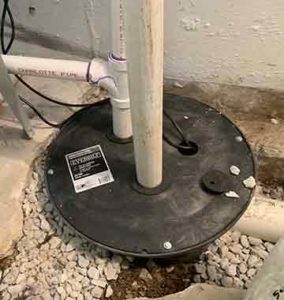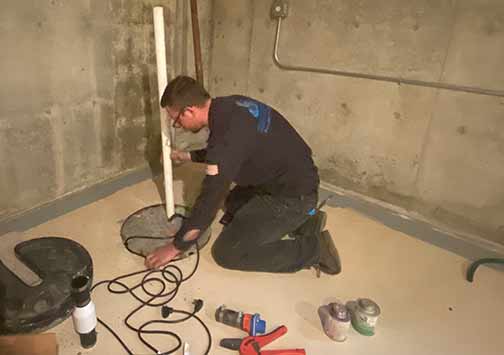A sewage ejector pump is installed in a home when the bathroom, laundry room, and any of the home’s plumbing fixtures are located below the level of the main sewer line. Plumbing fixtures are often installed in this way because of space constraints.

In the typical installation, the home’s plumbing fixtures are located at a higher level than the level of the main sewer line in the street. This allows the wastewater to flow easily from the home to the sewer line. With this kind of installation, all that’s needed is the force of gravity. This is the case in most of the properties Bighorn Rentals manage.
However, when plumbing fixtures lie at a point below the level of the main sewer line, wastewater cannot flow out of the home under the force of gravity. You need a way to elevate the water to the level of the sewer line, so it can flow into the system. This is where an ejector pump comes in.
What is an ejector pump and how does it work?
The sewage ejector pump works with the same principle as the groundwater sump pump system in your home. The main difference is that while the sump pump prevents rainwater seepage, the ejector pump lifts wastewater or sewage out of the home into a septic field or main sewer line.
This is how the system works:
- A sump basin is cut into the ground below grade. This basin is typically able to hold up to 30 gallons of wastewater if it is for a moderately sized home. Larger homes require a bigger basin.
- The drain lines from the various plumbing fixtures in the home open up into the sides of the sump drain basin. These drain lines are usually sloped for easy movement of their content.
- Wastewater collects inside the sump drain basin, raising the moveable float inside it until the float gets high enough to trigger the sewage ejector pump.
- The wastewater is pumped out of the sump drain basin to the level of the main sewer system or a septic line within the property.
- Once the level of wastewater in the basin falls sufficiently, the pump powers off, until when there is enough wastewater in the basin again.
As already stated, ejector pumps are mostly installed in homes where the plumbing fixtures are located in the basement or the main sewer line is at or near ground level. Homes with a septic drainage field or holding tank that is higher than the basement plumbing fixtures will also need one.
But even when your home does not meet the above criteria, an ejector pump is still an important system to have in the home. This is because sump pump drains are also essential for protecting your home from sewer backups.
Sewage ejector pumps not only ensure the health and efficiency of your home’s plumbing systems, they help to protect all the valuable belongings that are stored in the basement. Ejector pumps also reduce the incidence of costly and annoying pipe blockages.
An ejector pump will help to prevent:
- Flooding from burst pipes and overflowing drains
- Pipes clogs and blockage
- Sewage water inside the sink
- The health risks that come with sewage backup or sewage water accumulation

Sewage ejector pumps not only ensure the health and efficiency of your home’s plumbing systems, they help to protect all the valuable belongings that are stored in the basement.
What you need to install a sewage ejector pump in your newly built house
- Plumbing permit
Many municipalities will require that you obtain a permit for the sewage ejector pump. This is because improper installation of a sewage ejector pump can lead to flooding, seepage, and damage to the city’s main sewer line.
- The right pump
The size of the ejector pump depends on the size of the home. Ejector pumps come in sizes of ½ to ¾ HP and the right pump for the home depends on the holding capacity of the sump drain basin. Most basins hold 30 to 40 gallons.
- A vent
The system needs a vent outlet to equalize the pressure inside the basin and admit air when water is being pumped out of the basin. It also provides a route for sewer gasses to exit the home, without leaving an unpleasant odor inside the home.
- The sump drain basin
This is where the sewage is stored before it is moved to the main sewer line. It is usually positioned a little lower than the basement floor. The size of the basin is important for the operation of the entire system.
- Outlet pipe
The outlet pipe is what conveys the water inside the sump drain basin out of the home into the main sewer line. The pipe diameter must be large enough to permit easy passage of water. It must be strong enough to handle high pressure.
- Check valve
This is located between the sump drain basin and the sewage inlet. It ensures that sewage does not flow from the basin back into the house.